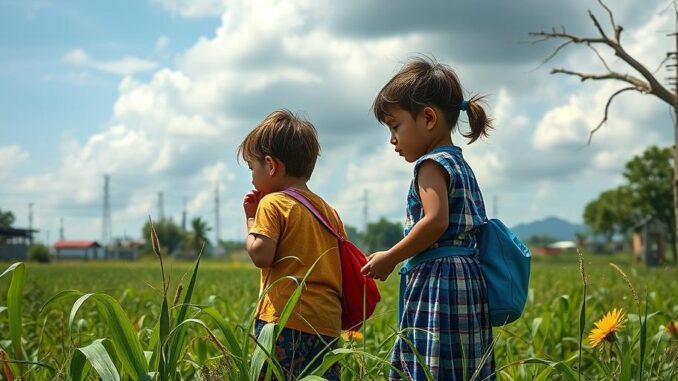
Summary
A recent study reveals a link between early-life exposure to air and light pollution and an increased risk of pediatric thyroid cancer. Researchers found that exposure to fine particulate matter and outdoor artificial light at night during the perinatal stage significantly increases the risk. This discovery emphasizes the importance of mitigating these environmental factors to protect children’s health.
Healthcare data growth can be overwhelming scale effortlessly with TrueNAS by Esdebe.
** Main Story**
Okay, so I saw this study recently that I thought was worth flagging, especially considering we’re both spending so much time thinking about public health these days. It’s about the connection between early pollution exposure and thyroid cancer in kids. Scary stuff, right? It appeared in Environmental Health Perspectives and it definitely caught my attention. Basically, researchers at Yale found a pretty strong link.
Alarming Findings from Yale
The Yale team looked into the effects of fine particulate matter (PM2.5) and artificial light at night (O-ALAN) – the stuff you find in cities, you know? What they found was really concerning: kids exposed to these pollutants early in life seemed to have a higher risk of developing papillary thyroid cancer before they even hit 20.
To break it down, they analyzed data from over 700 kids in California diagnosed with this cancer, comparing them to a large control group. Using some pretty sophisticated mapping techniques, they estimated how much PM2.5 and O-ALAN each child was exposed to at birth, based on where they lived. And guess what? For every small increase in PM2.5 levels, the odds of developing thyroid cancer went up. Not by a little, either; by 7%! That’s… substantial.
But here’s where it gets even more worrying. Teenagers and Hispanic children seemed to be even more at risk. The risk for teens was up 8%, for Hispanic children, a staggering 13%! And the light pollution? Kids in highly lit areas were almost 25% more likely to get this type of cancer. I mean, wow, that’s really something to consider when thinking about urban planning.
The Culprits: PM2.5 and O-ALAN
So, why these two? Well, PM2.5 is nasty stuff. It comes from cars, factories – you name it. It’s tiny, so it gets right into your bloodstream and messes with your hormones, throwing everything out of whack. That can lead to cancer development, or so the theory goes. And then there’s O-ALAN, that constant glow in cities. It messes with melatonin, screwing up sleep cycles, and those hormones play a role in cancer regulation too. It’s like a double whammy.
What Does This Mean for Us, and More Importantly, Our Kids?
That said, what are we supposed to do? This study just reinforces the need to seriously clamp down on pollution. It’s not just about cleaner air; it’s about protecting our kids’ futures. According to Dr. Deziel, she’s worried; and honestly, so am I. We need better pollution control, especially in cities, and we need it now. Further research is needed, but it should be prioritized.
It’s not all doom and gloom though. There are always advances in technology, and it will be interesting to see how those are used to solve this problem.
Bright Spots: Advances in Pediatric Cancer Care
Despite the somber news, there’s progress being made in how we detect and treat pediatric thyroid cancer. Think about it: non-invasive screening methods, better imaging tech, specialized blood tests – these mean earlier detection with less stress for kids. Plus, wearable tech can monitor vital signs, giving doctors a heads-up on potential problems way earlier than before.
And it doesn’t stop there! Targeted therapies are becoming more common, focusing on specific disease pathways to minimize side effects, you know? And as a result, telemedicine is helping reach kids in remote areas, bridging those geographical gaps. All of this makes me think; what can’t we do with the latest tech?
AI and VR are also on the horizon, which should help diagnosis and treatment, further enhancing communication. I think the key takeaway here, though, is that it’s crucial to work together: researchers, politicians, healthcare providers… we all have a role to play. Because only then can we create a healthier environment for the next generation. What do you think?


The rise in targeted therapies is a promising area of advancement. Focusing on specific disease pathways offers the potential to minimize side effects, which is particularly vital in pediatric cancer care. I’m interested to see how these therapies continue to evolve and improve outcomes.
I agree! The potential of targeted therapies is incredibly exciting, especially in pediatric cancer. I’m particularly curious about how personalized medicine, tailoring treatments to individual genetic profiles, will play a role in further minimizing side effects and improving long-term outcomes. It’s a very hopeful area of research.
Editor: MedTechNews.Uk
Thank you to our Sponsor Esdebe
So, cities are giving kids thyroid cancer now? Guess I’ll start investing in blackout curtains and bubble wrap… but seriously, should we be funding more research into urban lighting alternatives or just moving everyone to the countryside?